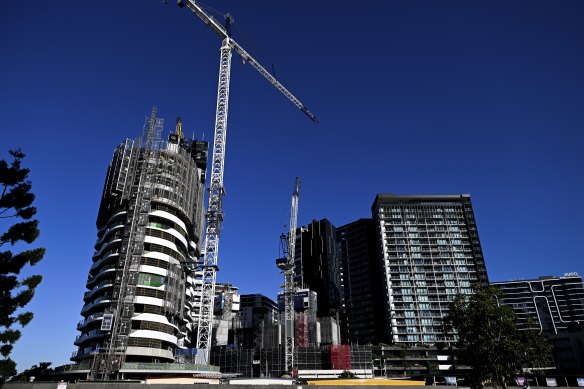
Fortis is also taking advantage of weak demand for development sites to acquire and launch new residential projects.
Loading
Marc Colella, a senior executive with global engineering and consultancy firm AECOM, said developers like Fortis in the top-end of the market were able to push ahead with projects, but mid-tier and more affordable players were hamstrung.
“With rising construction costs and apartment values not increasing sufficiently, they’re just not getting those apartments away,” Colella said.
“They [developers] are not going to start construction on a loss-making scheme. They don’t work that way. There are some fundamental issues over the next couple of years with the supply of affordable and mid-level, medium to high density construction,” he said.
The housing squeeze is directly related to strong migration into Australia. Net overseas migration – the growth or decline in population – over the year to June 2023 was 528,000 people, the highest since records began.
Net migration is expected to drop back to nearly half that figure this financial year but is still likely to grow at around 2 per cent in coming years, according to the ABS and Centre for Population.

The apartment market is taking much longer than initially anticipated to recalibrate after the pandemic.Credit: Dan Peled
The housing shortage has sent rents skyrocketing, with high-interest rates raising the barrier to entry for new home owners and inflation eating into static incomes.
In Melbourne, foreign buyers are noticeably absent, local and interstate buyers are “stagnant and there is little urgency to make purchasing decisions,” the report said.
There will only be meaningful market momentum when cash rates are cut, the federal election is decided and when various taxes and charges are rationalised
Charter Keck Kramer’s State of The Market report
Apartment launches in Victoria are at their lowest level in 15 years with 2100 apartments launched in the first half of this year. Developers and financiers are apprehensive about starting projects as pre-sales are extremely slow and projects remain for the most part financially unfeasible.
“Our apartment database shows that build times of projects have also increased due to the shortage of materials and labour and there is a distinct lack of finishing trades (or cashflow available to pay these trades) available for several projects,” the report said.
Many third-party builders aren’t prepared to take on high density projects because of construction risk, which will translate into anaemic levels of apartment supply over the next two to three years.
“This is a devastating outcome for housing and rental affordability and all but destines the housing targets set out in Victoria’s Housing Statement to failure,” Charter Keck said.
Colella said builders had struggled through a period of volatility and weren’t prepared to take on risky projects. “They’ve got present challenges with resources and material and labour costs on the increase,” he said.
The impact of the pandemic has been underestimated, Charter Keck maintains. The apartment market is taking much longer than initially anticipated to recalibrate, but on the upside housing may start to return to equilibrium over the next three to six months if interest rates are cut.
“There will only be meaningful market momentum when cash rates are cut, the federal election is decided and when various taxes and charges are rationalised,” the report states.
The Business Briefing newsletter delivers major stories, exclusive coverage and expert opinion. Sign up to get it every weekday morning.



























